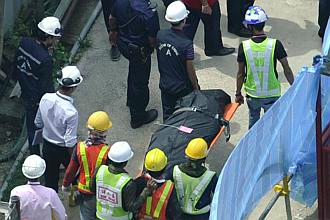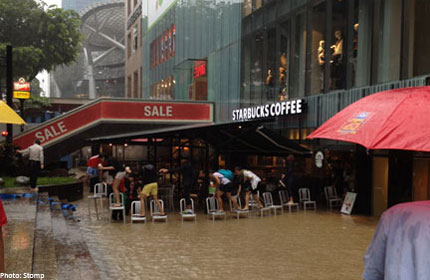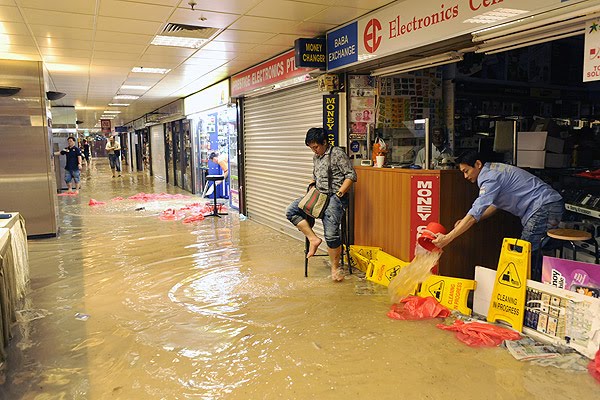Ah tiong land bagus, building new and better infrastructure,,,unlike ang mor lands,,,,with decaying infrastructure,,,soon ah tiong land number 1,,,the whole world will bow to them,,,
Genoa bridge collapse a sign of things to come if infrastructure maintenance ignored
By Colin Caprani
Updated Fri at 11:34am
 PHOTO: Italy has been struck in recent years by a number of bridge collapses of this type. (AP: Luca Zennaro)
RELATED STORY: 'What do you mean collapsed?': Audio reveals operator's shock at Genoa bridge collapse
RELATED STORY: 'A piece of our heart has remained under the rubble': Tributes for bridge victims
RELATED STORY: 'Apocalyptic scene': Italian bridge collapse in pictures
PHOTO: Italy has been struck in recent years by a number of bridge collapses of this type. (AP: Luca Zennaro)
RELATED STORY: 'What do you mean collapsed?': Audio reveals operator's shock at Genoa bridge collapse
RELATED STORY: 'A piece of our heart has remained under the rubble': Tributes for bridge victims
RELATED STORY: 'Apocalyptic scene': Italian bridge collapse in pictures
The
collapse of the Ponte Morandi in Genoa has shocked the world. People rightly expect that bridges do not fall down.
But there are no absolutes — engineering science is not perfect, and there is much we don't yet know.
Worse, without structural health monitoring of aged structures, we have little opportunity to learn from failures and make better predictions about future collapses.
Finally, bridge owners are always under pressure to increase the loads allowed and reduce the costs involved in inspection and maintenance, all while keeping open critical transport routes.
But first let's put the Genoa tragedy in context: bridges are the safest of all major structures — more so than buildings and dams.
The risk of fatality from a bridge collapse is about
one in 100 million per year, which is roughly 100 times less likely than being struck by lightning.
And given that there are about 1 trillion bridges crossings annually, the risk in terms of exposure is remarkably low.
Nevertheless, these statistics originate from a time when the vast majority of bridges constructed are within their intended design working lives.
Many bridges are beyond their design life
 PHOTO: The collapse of a pedestrian bridge in Miami killed four. (AP: DroneBase)
PHOTO: The collapse of a pedestrian bridge in Miami killed four. (AP: DroneBase)
Many of the bridges of the developed nations are at the end of
their design lives. More than half of Europe's
1 million bridges are beyond their 50 years design life.
Some
30 per cent of bridges in the US are listed as functionally obsolete or structurally deficient.
What caused the Genoa bridge collapse?

We've looked at what experts say might have caused the Morandi Bridge to fall down.
About 70 per cent of Australia's bridges are more than 50 years old. Against the backdrop of this ageing profile, there is pressure to allow heavier and heavier vehicles on the road network, and traffic volumes are such that densely-packed trucks in traffic jams are more and more frequent.
And as if that wasn't enough, there is a dash to have
automated truck platoonsfeaturing closely spaced trucks moving at full highway speed across our network.
Natural hazards, overloading, deterioration and foundation problems are the leading causes of bridge collapse. But most failures can be thought of as early-life failures and end-of-life failures, a phenomenon known as the
bathtub curve.
The collapse of the
West Gate Bridge in 1970, or the collapse of the
FIU Pedestrian Bridge in Florida in March, are examples of early-life collapses.
Increasingly though, because of the increasing age profile of our bridge stock, we are likely to see more end-of-life failures, such as that in Genoa this week.
Indeed, Italy has been struck in recent years by
a number of bridge collapses of this type, but anywhere with older bridges is susceptible.
 PHOTO: On October 15, 1970, while it was under construction, the West Gate Bridge collapsed, killing 35 workers. It was Victoria's worst ever workplace accident. (Supplied: Old Treasury Building)
Rush to blame clouds real issue
PHOTO: On October 15, 1970, while it was under construction, the West Gate Bridge collapsed, killing 35 workers. It was Victoria's worst ever workplace accident. (Supplied: Old Treasury Building)
Rush to blame clouds real issue
A real concern is that this trend will be obscured by the specific circumstances that unfolded in Genoa.
The rush to attribute blame that is evident now in Italy, and that occurs each time such a tragedy occurs, is certainly natural, but can cloud the real issue.
Finding one person or agency at fault in Italy might falsely lead us to think that it cannot happen here in Australia.
Certainly in each instance there are specific circumstances that lead to a collapse, but these events cannot be seen as one-offs.
They are, sadly, part of a trend of increasing failures, and this trend is likely to worsen as deterioration and increasing freight and traffic loads take their toll.
 PHOTO: It's surely time that smart sensing solutions are mandated for use across all our aged infrastructure to protect people from events like the Genoa bridge collapse. (AP: Luca Zennaro/ANSA)
No-one cuts a ribbon when a bridge is repaired
PHOTO: It's surely time that smart sensing solutions are mandated for use across all our aged infrastructure to protect people from events like the Genoa bridge collapse. (AP: Luca Zennaro/ANSA)
No-one cuts a ribbon when a bridge is repaired
The problem is compounded by decision-makers cutting inspection and maintenance budgets on the basis of collapses being historically unlikely, just as their likelihood is increasing.
 PHOTO: The Governor of Queensland cutting the ribbon at the opening of the Story Bridge, Brisbane, 1940. (Sourced: John Oxley Library/State Library of Queensland)
PHOTO: The Governor of Queensland cutting the ribbon at the opening of the Story Bridge, Brisbane, 1940. (Sourced: John Oxley Library/State Library of Queensland)
Bridge management, inspection and maintenance is somewhat costly, and the indications from
Victoria and
NSWare not ideal. But the costs of a calamity — human, social, economic and reputational — far outweigh the costs of proper care.
At present, bridge managers prioritise inspection and maintenance on the basis of the budget made available to them. This should be reversed — the budget allocated should be that required to maintain an acceptable and quantifiable level of public safety.
Of course, compared to large-scale
new pieces of infrastructure, though, these maintenance costs are not as attractive to decisionmakers or the public; no-one cuts a ribbon when an old bridge is repaired.
SHM is good technology, sparsely used
Happily, the technology to allow us keep our existing bridges operational, and load them to full utilisation, does exist.
Tales of survival from bridge collapse

From a former Italian Serie A goalkeeper and a grocery truck driver on the bridge, to a man under the highway, tales of survival are emerging from the moment the Morandi bridge in Italy collapsed.
Structural health monitoring (SHM) systems use sensors to measure both the response of a structure and the loads acting on it. This gives bridge engineers invaluable information on how bridges behave in the field, rather than just in a laboratory.
Unfortunately, SHM is quite sparsely implemented, even though it's not particularly costly.
Victoria and NSW, for example, have just
a handful of real-time SHM systemsin operation, and (to the author's knowledge) none are stipulated for use in the mega-projects currently being constructed.
This severely limits the opportunity for bridge engineers to learn from past failures, predict future failures, and improve our future designs.
Contrast this with the aerospace industry in which almost every failure has a full data stream to facilitate accurate diagnosis and protection against similar failures in the future.
It's surely time that smart sensing solutions are mandated for use across all our aged infrastructure to protect people from events like the Genoa bridge collapse, while making best economic use of the assets we already have.
 PHOTO: We must facilitate and resource our engineers to be proactively vigilant on the public's behalf. (891 ABC Adelaide: Brett Williamson)
Non-engineers shouldn't be the decisionmakers
PHOTO: We must facilitate and resource our engineers to be proactively vigilant on the public's behalf. (891 ABC Adelaide: Brett Williamson)
Non-engineers shouldn't be the decisionmakers
Australians are not to worry about their bridges for now — the risk of fatality is very low.
However, we share in the problems of the developed nations with ageing bridge stocks.
We cannot look to past trends or specific explained-away failures to give some sense of reassurance and safety; we must facilitate and resource our engineers to be proactively vigilant on the public's behalf.
Non-engineers should not be involved in decision-making — professional autonomy of those responsible for public safety ought to be ensured.
Colin Caprani is a bridge engineer and senior lecturer in Civil Engineering at Monash University.









 PHOTO: Italy has been struck in recent years by a number of bridge collapses of this type. (AP: Luca Zennaro)
PHOTO: Italy has been struck in recent years by a number of bridge collapses of this type. (AP: Luca Zennaro) PHOTO: The collapse of a pedestrian bridge in Miami killed four. (AP: DroneBase)
PHOTO: The collapse of a pedestrian bridge in Miami killed four. (AP: DroneBase)
 PHOTO: On October 15, 1970, while it was under construction, the West Gate Bridge collapsed, killing 35 workers. It was Victoria's worst ever workplace accident. (Supplied: Old Treasury Building)
PHOTO: On October 15, 1970, while it was under construction, the West Gate Bridge collapsed, killing 35 workers. It was Victoria's worst ever workplace accident. (Supplied: Old Treasury Building) PHOTO: It's surely time that smart sensing solutions are mandated for use across all our aged infrastructure to protect people from events like the Genoa bridge collapse. (AP: Luca Zennaro/ANSA)
PHOTO: It's surely time that smart sensing solutions are mandated for use across all our aged infrastructure to protect people from events like the Genoa bridge collapse. (AP: Luca Zennaro/ANSA) PHOTO: The Governor of Queensland cutting the ribbon at the opening of the Story Bridge, Brisbane, 1940. (Sourced: John Oxley Library/State Library of Queensland)
PHOTO: The Governor of Queensland cutting the ribbon at the opening of the Story Bridge, Brisbane, 1940. (Sourced: John Oxley Library/State Library of Queensland)
 PHOTO: We must facilitate and resource our engineers to be proactively vigilant on the public's behalf. (891 ABC Adelaide: Brett Williamson)
PHOTO: We must facilitate and resource our engineers to be proactively vigilant on the public's behalf. (891 ABC Adelaide: Brett Williamson)













